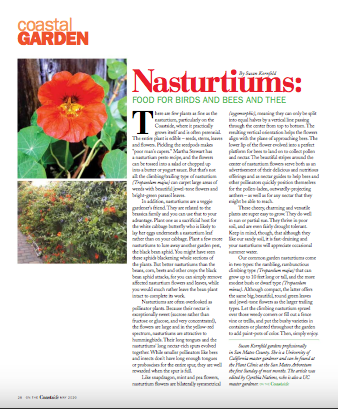There are few plants as fine as the nasturtium, particularly coastside, where it practically grows itself and is often perennial. The entire plant is edible – seeds, stems, leaves, and flowers. Pickling the seedpods makes "poor man's capers." Martha Stewart has a nasturtium pesto recipe, and the flowers can be tossed into a salad or chopped up into a butter or yogurt sauce. But that's not all: the climbing/trailing type of nasturtium (Tropaeolum majus) can carpet large areas of weeds with beautiful jewel-tone flowers and bright-green parasol leaves.
In addition, nasturtiums are a veggie gardener's friend. They are related to the brassica family and you can use that to your advantage. Plant one as a sacrificial host for the white cabbage butterfly who is likely to lay her eggs underneath a nasturtium leaf rather than on your cabbage. Plant a few more nasturtiums to lure away another garden pest, the black bean aphid. You might have seen these aphids blackening whole sections of the plants. But better nasturtiums than the beans, corn, beets and other crops the black bean aphid attacks, for you can simply remove affected nasturtium flowers and leaves, while you would much rather leave the bean plant intact to complete its work.
Nasturtiums are often overlooked as pollinator plants. Because their nectar is exceptionally sweet (sucrose rather than fructose or glucose, and very concentrated), the flowers are large and in the yellow-red spectrum, nasturtiums are attractive to hummingbirds. Their long tongues and the nasturtiums' long nectar-rich spurs evolved together. While smaller pollinators like bees and insects don't have long enough tongues or proboscises for the entire spur, they are well rewarded when the spur is full.
Like snapdragon, mint, and pea flowers, nasturtium flowers are bilaterally symmetrical (zygomorphic): they can only be split into equal halves by a vertical line passing through the center from top to bottom. The resulting vertical orientation helps the flowers align with the plane of approaching bees. The lower lip of the flower evolved into a perfect platform for bees to land on to collect pollen and nectar. The beautiful stripes around the center of nasturtium flowers serve both as an advertisement of their delicious and nutritious offerings and as nectar guides to help bees and other pollinators quickly position themselves for the pollen-laden outwardly-projecting anthers – as well as for any nectar that they might be able to reach.
These cheery, charming, and versatile plants are super easy to grow. They do well in sun or partial sun. They thrive in poor soil, and are even fairly drought tolerant. Keep in mind, though, that although they like our sandy soil, it is fast-draining and your nasturtiums will appreciate occasional summer water.
Our common garden nasturtiums come in two types: the rambling, rambunctious climbing type (Tropaeolum majus) that can grow up to ten feet long or tall; and the more modest bush or dwarf type (Tropaeolum minus). Although compact, the latter offers the same big, beautiful, round green leaves and jewel-tone flowers as the larger trailing types. Let the climbing nasturtium sprawl over those weedy corners or fill out a fence vine or trellis, and put the bushy varieties in containers or planted throughout the garden to add paint-pots of color. Then, simply enjoy.
Susan Kornfeld gardens professionally in San Mateo County. She is a UC Master Gardener and can be found at the Plant Clinic at the San Mateo Arboretum the first Sunday of most months. The article was edited by Cynthia Nations, UC Master Gardener.
Attached Images:
